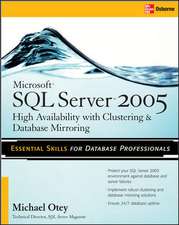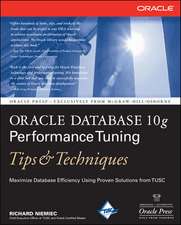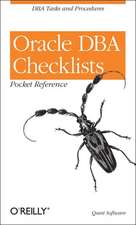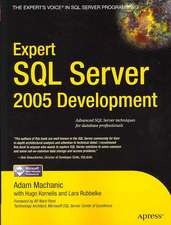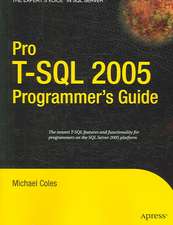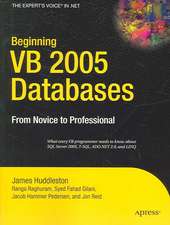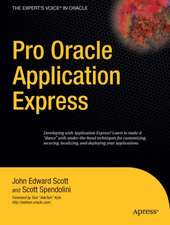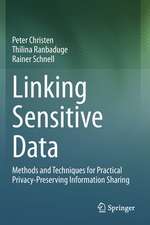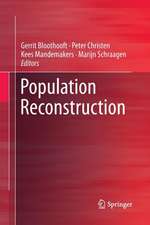Data Matching: Concepts and Techniques for Record Linkage, Entity Resolution, and Duplicate Detection: Data-Centric Systems and Applications
Autor Peter Christenen Limba Engleză Hardback – 5 iul 2012
Peter Christen’s book is divided into three parts: Part I, “Overview”, introduces the subject by presenting several sample applications and their special challenges, as well as a general overview of a generic data matching process. Part II, “Steps of the Data Matching Process”, then details its main steps like pre-processing, indexing, field and record comparison, classification, and quality evaluation. Lastly, part III, “Further Topics”, deals with specific aspects like privacy, real-time matching, or matching unstructured data. Finally, it briefly describes the main features of many research and open source systems available today.
By providing the reader with a broad range of data matching concepts and techniques and touching on all aspects of the data matching process, this book helps researchers as well as students specializing in data quality or data matching aspects to familiarize themselves with recent research advances and to identify open research challenges in the area of data matching. To this end, each chapter of the book includes a final section that provides pointers to further background and research material. Practitioners will better understand the current state of the art in data matching as well as the internal workings and limitations of current systems. Especially,they will learn that it is often not feasible to simply implement an existing off-the-shelf data matching system without substantial adaption and customization. Such practical considerations are discussed for each of the major steps in the data matching process.
| Toate formatele și edițiile | Preț | Express |
|---|---|---|
| Paperback (1) | 777.07 lei 3-5 săpt. | +19.63 lei 4-10 zile |
| Springer Berlin, Heidelberg – 9 aug 2014 | 777.07 lei 3-5 săpt. | +19.63 lei 4-10 zile |
| Hardback (1) | 888.26 lei 38-44 zile | |
| Springer Berlin, Heidelberg – 5 iul 2012 | 888.26 lei 38-44 zile |
Din seria Data-Centric Systems and Applications
- 20%
 Preț: 777.07 lei
Preț: 777.07 lei - 20%
 Preț: 430.26 lei
Preț: 430.26 lei - 20%
 Preț: 340.34 lei
Preț: 340.34 lei - 20%
 Preț: 337.91 lei
Preț: 337.91 lei - 20%
 Preț: 499.23 lei
Preț: 499.23 lei - 20%
 Preț: 1062.89 lei
Preț: 1062.89 lei - 20%
 Preț: 344.76 lei
Preț: 344.76 lei - 20%
 Preț: 663.61 lei
Preț: 663.61 lei - 20%
 Preț: 607.51 lei
Preț: 607.51 lei - 20%
 Preț: 347.74 lei
Preț: 347.74 lei - 20%
 Preț: 512.72 lei
Preț: 512.72 lei - 20%
 Preț: 339.14 lei
Preț: 339.14 lei - 20%
 Preț: 698.57 lei
Preț: 698.57 lei - 20%
 Preț: 650.27 lei
Preț: 650.27 lei - 20%
 Preț: 375.69 lei
Preț: 375.69 lei - 20%
 Preț: 420.84 lei
Preț: 420.84 lei - 20%
 Preț: 479.30 lei
Preț: 479.30 lei - 20%
 Preț: 321.70 lei
Preț: 321.70 lei - 20%
 Preț: 726.16 lei
Preț: 726.16 lei - 20%
 Preț: 333.50 lei
Preț: 333.50 lei - 20%
 Preț: 834.36 lei
Preț: 834.36 lei - 20%
 Preț: 333.88 lei
Preț: 333.88 lei - 20%
 Preț: 520.82 lei
Preț: 520.82 lei
Preț: 888.26 lei
Preț vechi: 1110.32 lei
-20% Nou
Puncte Express: 1332
Preț estimativ în valută:
169.99€ • 176.82$ • 140.34£
169.99€ • 176.82$ • 140.34£
Carte tipărită la comandă
Livrare economică 10-16 aprilie
Preluare comenzi: 021 569.72.76
Specificații
ISBN-13: 9783642311635
ISBN-10: 3642311636
Pagini: 292
Ilustrații: XX, 272 p.
Dimensiuni: 155 x 235 x 22 mm
Greutate: 0.59 kg
Ediția:2012
Editura: Springer Berlin, Heidelberg
Colecția Springer
Seria Data-Centric Systems and Applications
Locul publicării:Berlin, Heidelberg, Germany
ISBN-10: 3642311636
Pagini: 292
Ilustrații: XX, 272 p.
Dimensiuni: 155 x 235 x 22 mm
Greutate: 0.59 kg
Ediția:2012
Editura: Springer Berlin, Heidelberg
Colecția Springer
Seria Data-Centric Systems and Applications
Locul publicării:Berlin, Heidelberg, Germany
Public țintă
ResearchCuprins
Part I Overview.- Introduction.- The Data Matching Process.- Part II Steps of the Data Matching Process.- Data Pre-Processing.- Indexing.- Field and Record Comparison.- Classification.- Evaluation of Matching Quality and Complexity.- Part III Further Topics.- Privacy Aspects of Data Matching.- Further Topics and Research Directions.- Data Matching Systems.
Recenzii
"The book is very well organized and exceptionally well written. Because of the depth, amount, and quality of the material that is covered, I would expect this book to be one of the standard references in future years." William E. Winkler, U.S. Bureau of the Census, Washington, DC, USA
Notă biografică
Peter Christen is Senior Lecturer at the Research School of Computer Science at the Australian National University in Canberra, Australia. His research interests are data mining, with a focus on data matching, and privacy-preserving data sharing and mining. He has published over 50 papers in these areas, and he is the principle developer of the `Febrl' (Freely Extensible Biomedical Record Linkage) open source data cleaning, deduplication and record linkage system.
Textul de pe ultima copertă
Data matching (also known as record or data linkage, entity resolution, object identification, or field matching) is the task of identifying, matching and merging records that correspond to the same entities from several databases or even within one database. Based on research in various domains including applied statistics, health informatics, data mining, machine learning, artificial intelligence, database management, and digital libraries, significant advances have been achieved over the last decade in all aspects of the data matching process, especially on how to improve the accuracy of data matching, and its scalability to large databases.
Peter Christen’s book is divided into three parts: Part I, “Overview”, introduces the subject by presenting several sample applications and their special challenges, as well as a general overview of a generic data matching process. Part II, “Steps of the Data Matching Process”, then details its main steps like pre-processing, indexing, field and record comparison, classification, and quality evaluation. Lastly, part III, “Further Topics”, deals with specific aspects like privacy, real-time matching, or matching unstructured data. Finally, it briefly describes the main features of many research and open source systems available today.
By providing the reader with a broad range of data matching concepts and techniques and touching on all aspects of the data matching process, this book helps researchers as well as students specializing in data quality or data matching aspects to familiarize themselves with recent research advances and to identify open research challenges in the area of data matching. To this end, each chapter of the book includes a final section that provides pointers to further background and research material. Practitioners will better understand the current state of the art in data matching as well as the internal workings and limitations of current systems. Especially, theywill learn that it is often not feasible to simply implement an existing off-the-shelf data matching system without substantial adaption and customization. Such practical considerations are discussed for each of the major steps in the data matching process.
Peter Christen’s book is divided into three parts: Part I, “Overview”, introduces the subject by presenting several sample applications and their special challenges, as well as a general overview of a generic data matching process. Part II, “Steps of the Data Matching Process”, then details its main steps like pre-processing, indexing, field and record comparison, classification, and quality evaluation. Lastly, part III, “Further Topics”, deals with specific aspects like privacy, real-time matching, or matching unstructured data. Finally, it briefly describes the main features of many research and open source systems available today.
By providing the reader with a broad range of data matching concepts and techniques and touching on all aspects of the data matching process, this book helps researchers as well as students specializing in data quality or data matching aspects to familiarize themselves with recent research advances and to identify open research challenges in the area of data matching. To this end, each chapter of the book includes a final section that provides pointers to further background and research material. Practitioners will better understand the current state of the art in data matching as well as the internal workings and limitations of current systems. Especially, theywill learn that it is often not feasible to simply implement an existing off-the-shelf data matching system without substantial adaption and customization. Such practical considerations are discussed for each of the major steps in the data matching process.
Caracteristici
First book on a topic of growing importance for applications Brings together research from various areas like databases, statistics, information retrieval, data mining, and machine learning Details the data matching process step by step Includes an overview of freely available data matching systems and a detailed discussion of practical aspects and limitations Includes supplementary material: sn.pub/extras Includes supplementary material: sn.pub/extras

